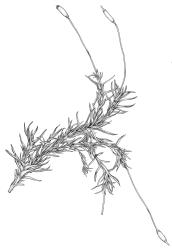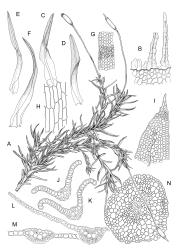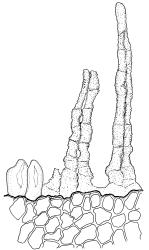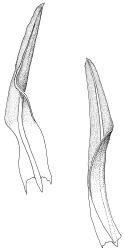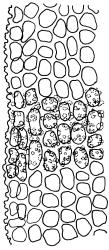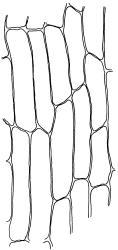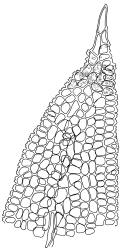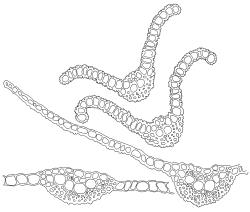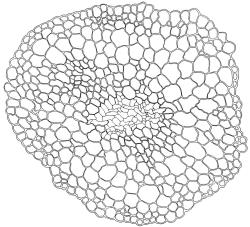- ≡ Weissia recurvirostra Hedw., Sp. Musc. Frond. 71 (1801)
- ≡ Erythrobarbula recurvirostra (Hedw.) Steere, Bryologist 54: 191 (1951)
- = Didymodon rubellus var. dentatus Schimp., Syn. Musc. Eur. 131 (1860)
- ≡ Erythrobarbula recurvirostra var. dentata (Schimp.) Sainsbury, Bull. Roy. Soc. New Zealand 5: 159 (1955) nom. inval.
- ≡ Bryoerythrophyllum recurvirostrum var. dentatum (Schimp.) H.A.Crum, Steere & L.A.Anderson, Bryologist 67: 163 (1964)
- = Didymodon erubescens Mitt. in Hooker, Handb. New Zealand Fl. 421 (1867)
- = Trichostomum curvithecum R.Br.bis, Trans. & Proc. New Zealand Inst. 29: 487–488 (1897)
Plants yellow-green above, red-brown below, forming dense tufts. Stems 10–15 mm, sparsely tomentose below, central strand present, sclerodermis weakly developed. Leaves erect-spreading from a ± sheathing base when moist, flexuose and individually twisted when dry, 2–3 mm, linear-lanceolate from a broader base, carinate, narrowly acute, sometimes with a hyaline apiculus; margins recurved, crenulate-papillose, often irregularly denticulate at the apex; upper laminal cells obscure, subquadrate, firm-walled, pluripapillose with complex papillae, (7.5–)10.0–12.0(–14.0) × (7.5–)9.0–10.0(–11.0) µm, becoming longer towards the leaf base; upper marginal cells ± oblate in 1 or 2 rows; lower laminal cells conspicuously but gradually differentiated from upper laminal cells, hyaline, rectangular to long-hexagonal, lax and thin-walled, smooth, with c. 5 rows at the margin narrower and firm-walled, forming a weak border. Costa stout, percurrent, at mid leaf with stereids exposed on abaxial face only; adaxial superficial cells as adjacent laminal cells; abaxial superficial cells at mid leaf fusiform, thick-walled and papillose. Laminal KOH colour reaction orange-red to red.
Paroicous. Perichaetial leaves shorter than vegetative leaves, abruptly acuminate from a sheathing base. Perigonia not differentiated, with antheridia and paraphyses naked in axils of outer perichaetial leaves. Setae slender, flexuose, orange-red, 10–12 mm. Capsules brown, cylindric, sometimes weakly arcuate, 2–3 mm. Operculum bluntly rostrate, ⅓ the theca length. Peristome c. 375 µm, pale, of 16 straight teeth, perforated, densely papillose and weakly nodose, from a low basal cylinder. Spores 14–18 µm, finely papillose.
Magill 1981, fig. 72, 11–18; Lüth 2019, p. 595; Seppelt 2004, fig. 90, 1–14; Malcolm et al. 2020, p. 498 (as B. recurvirostre).
Features described for recognition of the genus Bryoerythrophyllum provide guidelines for both species. Shoots of B. recurvirostrum are more robust than those of B. dubium, with leaf margins ± recurved throughout their length. Differences in costal cross-section are given in the key.
NI: Gisborne (Maungapōhatu), Wellington (Ruahine Range); SI: Nelson, Canterbury, Westland, Otago, Southland; Ch; A; reported from M (Seppelt 2004).
Cosmopolitan? Reported from mainland Australia and Tasmania (Seppelt 2004).
Widespread in both hemispheres, in the tropics and to high latitudes (see Zander 1993; Smith 2004; Kurbatova & Ochyra 2013).
The species is generally found on calcareous soil or rock, or on concrete. Associated mosses include Bartramia papillata, Gimmia pulvinata, Hypnum cupressiforme, Lepyrodon australis, and Triquetrella tasmanica.
Records range from c. 15 m (Waitati, Otago L.D.) to 1650 m elevation (Mt Arthur, Nelson L.D.). The species appears to be very rare in the North I., where it is currently known from only two sites.
Bryoerythrophyllum recurvirostrum var. dentatum (Schimp.) H.A.Crum, Steere & L.E.Anderson was accepted by Sainsbury (1955, p. 160) for N.Z. (as Erythrobarbula recurvirostra var. dentata) on the authority of H.N. Dixon. A specimen (WELT M016162) that was initially labelled D. rubellus var. dentatus in Sainsbury’s hand is unremarkable B. recurvirostrum. Zander 1993 and Zander et al. 2007 are followed here in placing the variety in synonymy of B. recurvirostrum var. recurvirostrum.



